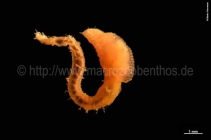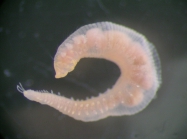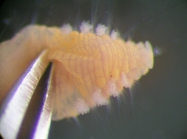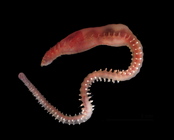
| Introduction | | Search taxa | | Taxon tree | | Taxon match | | Checklist | | Literature | | Stats | | Photogallery | | OBIS Vocab | | Log in |
CaRMS taxon detailsScalibregma Rathke, 1843
129555 (urn:lsid:marinespecies.org:taxname:129555)
accepted
Genus
Scalibregma inflatum Rathke, 1843 (type by monotypy)
marine,
recent only
neuter
Rathke, H. (1843). Beiträge zur Fauna Norwegens. <em>Nova Acta Academiae Caesareae Leopoldino-Carolinae Naturae Curiosorum, Breslau & Bonn.</em> 20: 1-264c., available online at https://doi.org/10.5962/bhl.title.11613
page(s): 182-184 [details]
Etymology Rathke (1843: 182, footnote) explains the derivation of Scalibregma as follows (translated): "The name is composed of...
Etymology Rathke (1843: 182, footnote) explains the derivation of Scalibregma as follows (translated): "The name is composed of (Greek for) front head and (Greek for) a tool for digging, scratching." Brown (1954) translates Greek bregma, -tos, neuter, as front part of the head, and Greek skalis -idos (feminine) as mattock or hoe. Thus Scalibregma means forehead hoe and the genus is neuter as the 2nd word bregma is neuter. [details]
Read, G.; Fauchald, K. (Ed.) (2024). World Polychaeta Database. Scalibregma Rathke, 1843. Accessed through: Nozères, C., Kennedy, M.K. (Eds.) (2024) Canadian Register of Marine Species at: https://www.marinespecies.org/carms/aphia.php?p=taxdetails&id=129555 on 2024-04-27
Nozères, C., Kennedy, M.K. (Eds.) (2024). Canadian Register of Marine Species. Scalibregma Rathke, 1843. Accessed at: https://marinespecies.org/carms/aphia.php?p=taxdetails&id=129555 on 2024-04-27
Date action by
original description
Rathke, H. (1843). Beiträge zur Fauna Norwegens. <em>Nova Acta Academiae Caesareae Leopoldino-Carolinae Naturae Curiosorum, Breslau & Bonn.</em> 20: 1-264c., available online at https://doi.org/10.5962/bhl.title.11613
page(s): 182-184 [details] additional source Fauchald, K. (1977). The polychaete worms, definitions and keys to the orders, families and genera. <em>Natural History Museum of Los Angeles County: Los Angeles, CA (USA), Science Series.</em> 28:1-188., available online at http://www.vliz.be/imisdocs/publications/123110.pdf [details] additional source Bellan, G. (2001). Polychaeta, <i>in</i>: Costello, M.J. <i>et al.</i> (Ed.) (2001). European register of marine species: a check-list of the marine species in Europe and a bibliography of guides to their identification. <em>Collection Patrimoines Naturels.</em> 50: 214-231. (look up in IMIS) note: checklist listing [details] additional source Day, J. H. (1967). [Sedentaria] A monograph on the Polychaeta of Southern Africa. Part 2. Sedentaria. British Museum (Natural History), London. pp. 459–842., available online at http://www.biodiversitylibrary.org/bibliography/8596 [details] identification resource Mendes, Samuel Lucas Da Silva Delgado; Rizzo, Alexandra E.; De Paiva, Paulo Cesar. (2023). Unravelling the diversity of Scalibregma Rathke, 1843 (Annelida: 'Polychaeta': Scalibregmatidae) from southeast Brazilian coast. <em>Zootaxa.</em> 5353(5): 441-454., available online at https://mapress.com/zt/article/view/zootaxa.5353.5.3 page(s): 452; note: Key to Scalibregma species [details] Available for editors  Present Present  Inaccurate Inaccurate  Introduced: alien Introduced: alien  Containing type locality Containing type locality
From editor or global species database
Diagnosis "Body elongate, arenicoliform. Prostomium T-shaped with lateral horns. Peristomium achaetous, surrounding prostomium dorsally and forming upper and lower lips of mouth ventrally. Parapodia of posterior segments with dorsal and ventral cirri; interramal papilla present; postsetal lamellae absent. Branchiae present in anterior segments. Setae include capillaries, lyrate setae, and sometimes inconspicuous blunt, pointed, or bifurcated spinous setae anterior to capillaries of setigers 1 or 1‒2, representing homologues of lyrate setae; large conspicuous acicular spines absent. Pygidium with long anal cirri." (Blake, 2015: 60). [details]Etymology Rathke (1843: 182, footnote) explains the derivation of Scalibregma as follows (translated): "The name is composed of (Greek for) front head and (Greek for) a tool for digging, scratching." Brown (1954) translates Greek bregma, -tos, neuter, as front part of the head, and Greek skalis -idos (feminine) as mattock or hoe. Thus Scalibregma means forehead hoe and the genus is neuter as the 2nd word bregma is neuter. [details] Grammatical gender Neuter. Rathke (1843) gave the type species a neuter species-group name, 'inflatum', consistent with his derivation etymology, and about six of the following names from later authors were given neuter adjectival species-group names. [details] |



